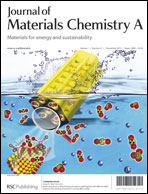Nanostructured Bi2S3/WO3 heterojunction films exhibiting enhanced photoelectrochemical performance†
Abstract
To improve the photoelectrochemical activity of WO3, Bi2S3/WO3 heterojunction films were designed by coupling WO3 films with varying amounts of urchin-like Bi2S3 nanospheres. The WO3 films were composed of WO3 nanoprism arrays, which were synthesized using a solvothermal method. After coating a single layer of Bi2S3 on top of the WO3 film, the resulting Bi2S3/WO3 heterojunction film showed enhanced photoelectrochemical activity. At 1.2 V vs. Ag/AgCl, the initial photocurrent density of the Bi2S3/WO3 heterojunction film with one layer of Bi2S3 was 1.33 mA cm−2 in 0.1 M Na2SO4 and 1.19 mA cm−2 in a 0.2 M NaCl mixed water–ethanol solution, which was 40% and 32% higher than the bare WO3 film under the same conditions, respectively. The optimal number of Bi2S3 layers for coupling with the WO3 film was found to be 3 layers, which had the highest photocurrent density and IPCE values. The photoelectrochemical activity of Bi2S3/WO3 heterojunction film was not stable for water oxidation due to photocorrosion in aqueous electrolyte, but it was stable in the NaCl mixed water–ethanol solution and a non-aqueous solution containing iodide/triiodide as a redox couple. The origin of enhanced photoelectrochemical activity of the Bi2S3/WO3 heterojunction film was primarily ascribed to the band potential matching between WO3 and Bi2S3, which is advantageous for charge separation.


 Please wait while we load your content...
Please wait while we load your content...